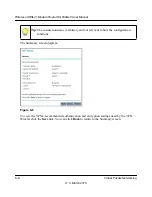
Wireless ADSL2+ Modem Router DG834Gv5 User Manual
5-6
Advanced Configuration
v1.0, March 2010
Using the Modem Router as a DHCP Server
By default, the modem router functions as a Dynamic Host Configuration Protocol (DHCP) server,
allowing it to assign IP, DNS server, and default gateway addresses to all computers connected to
the modem router’s LAN. The assigned default gateway address is the LAN address of the modem
router. IP addresses is assigned to the attached PCs from a pool of addresses specified in this
screen. Each pool address is tested before it is assigned to avoid duplicate addresses on the LAN.
For most applications, the default DHCP and TCP/IP settings of the modem router are satisfactory.
See the online document listed in
“Internet Networking and TCP/IP Addressing” in Appendix C
for an explanation of DHCP and information about how to assign IP addresses for your network.
Use Router as DHCP Server
If another device on your network will be the DHCP server, or if you will manually configure the
network settings of all of your computers, clear the
Use Router as DHCP Server
check box on
the LAN IP Setup screen. Otherwise, leave it selected.
Specify the pool of IP addresses to be assigned by filling in the
Starting IP Address
and
Ending
IP Address
fields. These addresses should be part of the same IP address subnet as the modem
router’s LAN IP address. Using the default addressing scheme, you should define a range between
192.168.0.2 and 192.168.0.254, although you might want to save part of the range for devices with
fixed addresses.
The modem router delivers the following parameters to any LAN device that requests DHCP:
•
An IP address from the range you have defined.
•
Subnet mask.
•
Gateway IP Address is the router’s LAN IP address.
•
Primary DNS server, if you entered a primary DNS address in the Basic Settings screen;
otherwise, the router’s LAN IP address.
•
Secondary DNS server, if you entered a secondary DNS address in the Basic Settings screen.
•
WINS Server (Windows Internet Naming Service Server), determines the IP address
associated with a particular Windows computer. A WINS server records and reports a list of
names and IP address of Windows PCs on its local network. If you connect to a remote
network that contains a WINS server, enter the server’s IP address here. This allows your PCs
to browse the network using the Network Neighborhood feature of Windows.






























